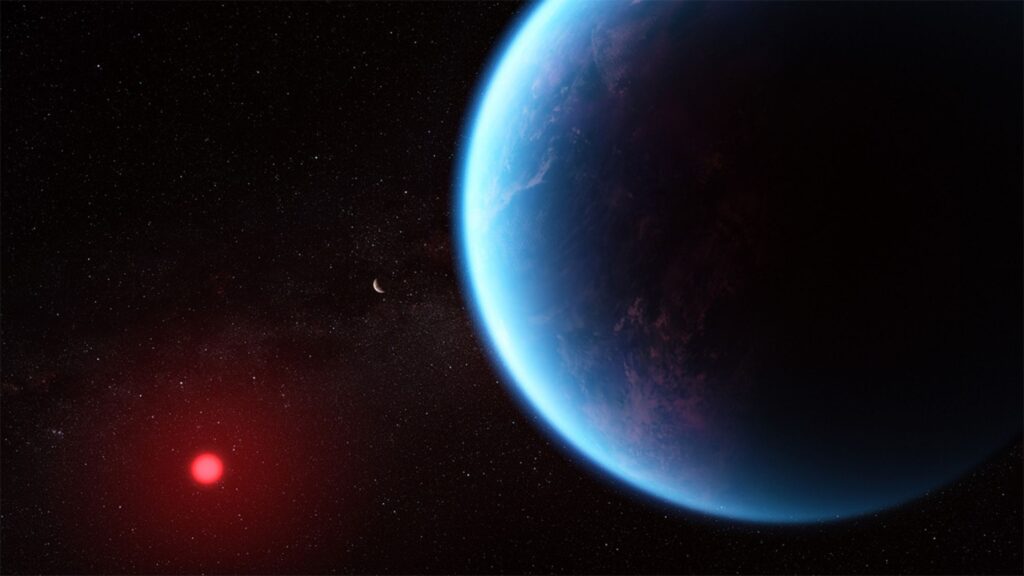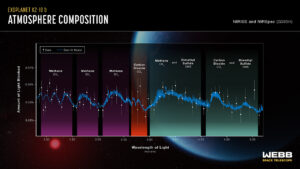Earth is the only planet with life on it. However, scientists and astrophysicists are working very hard to find planets with the potential to sustain life. It is crucial to research the propagation of species and understand more about the universe. According to some studies, the Milky Way Galaxy is home to over 60 billion planets within habitable zones. But out of all the potential planets, one has been in the headline; it’s the K2-18B—a planet 124 light-years away in the Leo constellation.
What makes K2-18B different from the rest of the planets, and why scientists are keen on discovering more about it? Also, there is some new data that reveals more insight about the planets. So, Let’s explore more about the K2-18B planet and its potential for sustaining life.
K2-18B Planet
It is one of the most widely studied exoplanets in recent times and has captured the attention of many astrobiologists. The presence of hydrogen and carbon has opened doors to the conversation of life beyond Earth. However, it is too early to say anything, and only further studies and observations can give a proper answer. Still, the efforts of scientists are neverending when it comes to the understanding and origin of life in the universe.
Basic information about K2-18B. (Reference)
- Planet Radius: 2.37 x Earth
- Planet Type: Super Earth
- Discovery Method: Transit
- Planet Mass: 8.92 Earths
- Discovery Date: 2015
- Orbital Radius: 0.1429 AU
- Orbital Period: 32.9 days
- Eccentricity: 0.2
The planet is 124 light-years away in the Leo constellation and was first detected by the Kepler Space Telescope/K2 mission in 2015. It orbits a red dwarf star known as K2-18 and lies in its habitable zone. Moreover, K2-18B is classified as a sub-neptune or mini-neptune exoplanet. It has a smaller radius than the Neptune but has a higher mass.
Exploring The Potential Of Life On K2-18B Planet
K2-18B lies in the K2-18 star system and lies in the habitable zone—a position with the maximum chances of sustaining life as we know it. The recent findings of water and other significant traces of elements like methane on K2-18B suggest the capabilities of the planet to sustain life. The first study came from the Hubble telescope, which indicated the presence of hydrogen in the atmosphere of the ocean (hydrogen-rich) planet.
Further studies and the most recent one came from the observation of the James Webb telescope. It traced the presence of dimethyl sulphide or DMS. This is an important compound that is synthesised by phytoplankton on Earth. Therefore, this could be an indicator of life on K2-18B. However, there are still many questions before coming to the conclusions.
Optimism Of Science Community Regarding K2-18B
The Hubble telescope detected water vapour in the atmosphere of K2-18B in 2019. After that, the scientists further continued their observation with the data from the James Webb Space Telescope. The findings in 2023 and 2024 completely shocked the scientific community. There were signs of carbon-bearing molecules—methane and carbon dioxide on the planet’s surface. On top of that, the detection of DMS, which is associated with life on Earth, was nothing short of a breakthrough.
- Water vapour in its atmosphere.
- Carbon-bearing molecules like methane and carbon dioxide.
- Detection of DMS (dimethyl sulfide) — associated with life on Earth.
There are a vast number of reasons for the findings. But the most ideal one is the position of the planet from the star. It lies in the habitable zone, which makes it a perfect candidate for supporting life. However, this is not all, as more empirical evidence will tell about the atmosphere of the planet K2-18B.
The Conditions for Life On Any Exoplanet
An exoplanet lies outside our star system, i.e., the solar system. Now, there is a wide range of indicators for exoplanets with potential for life. These include, first and foremost, organic compounds—water and methane. Liquid water, along with the right temperature and right atmosphere, forming a chemical complexity, is the basis of life. And even though K2-18B does not complete every criterion, it has much potential.

K2-18B has an atmosphere that can trap and support greenhouse gases. On top of that, the water vapour in the atmosphere is a potential indicator of evaporated water from the surface. However, not everything is perfect for the K2-18B planet, as it has a very high level of hydrogen in the air. This is not good for organic life as we have here on the Earth. But still, the planet has a lot of potential and only time will tell its complete story.
The Role of the James Webb Space Telescope In K2-18B Findings
JWST is one of the most advanced telescopes in the world. It is the next big thing after the honorary Hubble Telescope. Since its inception, the JWST has provided scientists with much crucial information, elevating our understanding of the universe. But how does it do this? Well, the importance of spectroscopy for identifying atmosphere components and using the latest imaging tools makes JWST a spectacle of technology.

Even though Hubble was capable of photographing the K2-18B and giving insight into water vapours in its atmosphere, JWST took it a step further. With a mirror 3 times wider and the capability of nine times that of Hubble, JWST was able to discover methane on the surface of the exoplanet. Moreover, further studies are sure to reveal more about the distant planet revolving around K2-18.
Hypothetical Life on K2-18b
There are so many questions about the existence of life on K2-18B. The present data is not enough to say anything about the presence of microbial life on the planet. It is because the atmosphere consists of high hydrogen levels—which could be a hindrance to organic. But it opens new doors to a more evolved form of life. Also, some studies suggest that there could be life in the upper layers of the atmosphere, but it’s just a hypothesis.

Many scientists compare the living conditions of K2-18B to the past Venus’s atmospheric life theories. It is an indication of the way life evolves on the different planetary surfaces. Moreover, the concepts of Super-Earth biospheres that are capable of supporting life. But there are many answers before making the following big assumption about life on planet K2-18B.
Scientific Challenges And Skepticism Surrounding K2-18B
One of the biggest questions about the findings on K2-18B is remote observation. Even with JWST and the latest technologies, it’s not possible to directly image the surface of the planet or check for life forms. On top of that, there are potential signal noise and contamination risks of the received data, which can be the source of chemical signatures.
- Remote observation.
- Signal losses and contamination.
- It is impossible to image the planet’s surface.
So, at the moment, the observations from K2-18B are an exciting discovery, but many are over-interpreting the data. Therefore, it’s crucial to stick with the empirical observations before concluding directly with the subsequent most significant discovery of human civilization. Finally, the new studies will give more insight into the planet and its potential for life.
What’s Next For The K2-18B Studies?
The upcoming JWST observations will reveal a lot more about K2-18B. Additionally, the ground-based telescopes are also aiding the search and providing many data to researchers. At the same time, K2-18B is not the only exoplanet under study, as scientists are always looking for new candidates. So, only time will tell more about the K2-18B.

The advancements in the field of studying biosignatures are also aiding the research. It is a way of inferring the presence of life with the available compounds on the exoplanets. With time and effort, more data can be studied, which is helpful to know about the life forms that may exist outside the solar system.
Final Thoughts On Planet K2-18B
K2-18B has shown many promises and presents the opportunity to study the secrets of the universe. It might be one of the planets with the potential to support life, but it’s too early to conclude anything. Scientists around the world need more data to confirm the existence of life-sustaining planets. If life is present on the K2-18B planet, then this could be the most significant step forward in the field of astrobiology. Finally, this particular research can bring us all one step closer to one of the biggest questions in the entirety of human existence: Are we alone?
FAQs
What is the k2 18b planet distance from Earth?
124 light years.
Where is the k2 18b planet?
K2-18B orbits an M-type star in the constellation Leo.
How was water found on k2 18b?
The data from the James Webb Telescope discovered the presence of water molecules on K2-18B.
How old is the image of k2 18b?
The planet was discovered in 2015.
When can we travel to planet k2-18b?
It would take millions of years to reach with the current propulsion technologies.
What is Planet k2 18b temperature?
The temperature range of the planet is -23 degrees to 27 degrees Celsius.
Does K2-18b have an atmosphere?
The 0.1-50 percent of the planet’s atmosphere comprises water vapours.
Why is K2-18b not habitable?
There is not enough data to suggest the feasibility of life on the planet.
Has NASA found a habitable planet?
There are many planets in the habitable zone of their star system. Out of this, TOI-715 b has shown significant promise for sustaining life.


